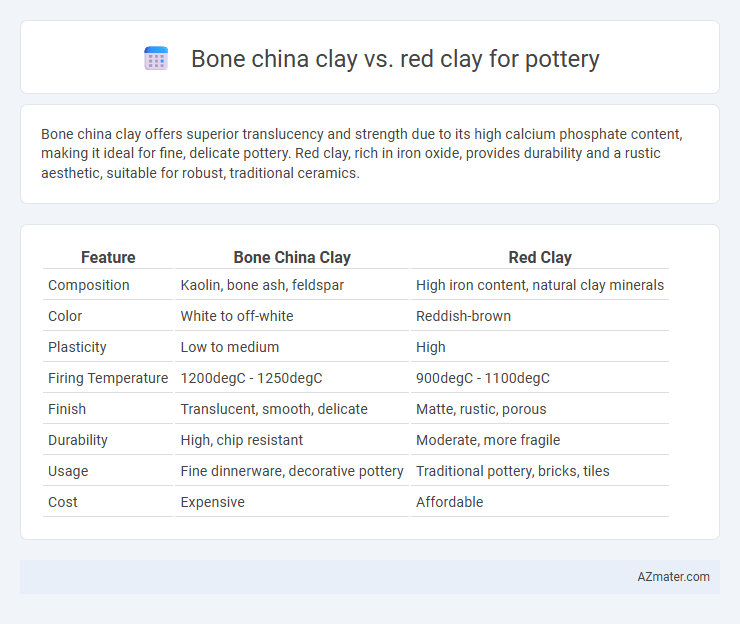Bone china clay offers superior translucency and strength due to its high calcium phosphate content, making it ideal for fine, delicate pottery. Red clay, rich in iron oxide, provides durability and a rustic aesthetic, suitable for robust, traditional ceramics.
Table of Comparison
| Feature | Bone China Clay | Red Clay |
|---|---|---|
| Composition | Kaolin, bone ash, feldspar | High iron content, natural clay minerals |
| Color | White to off-white | Reddish-brown |
| Plasticity | Low to medium | High |
| Firing Temperature | 1200degC - 1250degC | 900degC - 1100degC |
| Finish | Translucent, smooth, delicate | Matte, rustic, porous |
| Durability | High, chip resistant | Moderate, more fragile |
| Usage | Fine dinnerware, decorative pottery | Traditional pottery, bricks, tiles |
| Cost | Expensive | Affordable |
Understanding Bone China Clay and Red Clay
Bone china clay is a refined, high-quality porcelain clay containing bone ash, feldspar, and kaolin, prized for its strength, translucency, and white color after firing. Red clay, often known as terracotta, contains higher iron oxide content, giving it its characteristic reddish hue, and is commonly used for rustic, durable pottery with a porous texture. Understanding these clays involves recognizing bone china's suitability for delicate, fine tableware and red clay's ideal properties for robust, earthy ceramics and sculptural forms.
Key Differences in Raw Materials
Bone china clay contains a high proportion of bone ash, typically 40-50%, combined with kaolin and feldspar, which contributes to its translucency and strength. In contrast, red clay primarily consists of natural iron-rich clay minerals, which give it the distinctive red hue and high plasticity ideal for hand-building and throwing. These fundamental differences in raw materials result in bone china clay being suited for fine, delicate tableware, while red clay is preferred for rustic, durable pottery.
Color and Texture Comparison
Bone china clay offers a smooth, fine texture and a translucent white color that highlights delicate details in pottery, making it ideal for high-end ceramics. Red clay is coarser with a gritty texture and rich earthy red hues due to iron oxide content, giving rustic aesthetics and durability for functional pottery. The color variances directly impact firing temperatures and glaze reactions, with bone china requiring higher temperatures for vitrification compared to red clay's more forgiving range.
Firing Temperatures and Processes
Bone china clay requires higher firing temperatures around 1200-1400degC to achieve its characteristic translucency and strength, often utilizing a two-stage firing process including biscuit and glaze firings. Red clay, typically fired at lower temperatures between 900-1100degC, undergoes a simpler single-stage firing that emphasizes its rich iron content, resulting in a porous and earthy finish. The differences in firing temperatures and processes affect the durability, texture, and color outcome of pottery made from these clays.
Strength and Durability: Bone China vs Red Clay
Bone china clay exhibits superior strength and durability compared to red clay due to its high percentage of bone ash, which contributes to its density and resistance to chipping. Red clay, typically composed of iron-rich earthen materials, tends to be more porous and less resilient under stress, making it more prone to cracking and wear over time. The vitrification process in bone china ensures it remains strong and translucent, while red clay pottery generally requires higher firing temperatures to achieve comparable durability.
Aesthetic Outcomes: Surface Finish and Glaze Compatibility
Bone china clay produces a smooth, translucent surface finish that enhances glaze clarity and luster, ideal for fine, detailed pottery. Red clay, known for its rich, earthy tones and porous texture, creates a matte surface that interacts uniquely with matt or satin glazes, offering rustic and natural aesthetics. Glaze compatibility varies as bone china's high vitrification supports glossy and delicate glazes, whereas red clay's lower firing temperature favors reactive and textured glazes for artistic effects.
Workability for Potters
Bone china clay offers superior plasticity and smoothness, allowing potters to achieve fine, delicate details and thin walls with ease. Red clay, known for its coarser texture, provides excellent strength and durability but requires more skill to manipulate without cracking during the shaping and drying process. Workability in bone china clay is ideal for intricate designs, while red clay is better suited for robust, functional pottery forms.
Suitability for Various Pottery Styles
Bone china clay offers fine particle size and high vitrification suitable for delicate, translucent pottery styles like porcelain and intricate decorative pieces. Red clay, characterized by its iron content and coarse texture, excels in robust, rustic pottery such as terracotta and traditional earthenware. Each clay's mineral composition directly influences its suitability for wheel throwing, hand building, or sculptural techniques across diverse artistic applications.
Cost and Accessibility
Bone china clay typically costs more due to its refined composition and the inclusion of bone ash, which enhances translucency and strength, making it less accessible for beginner potters or those on a budget. Red clay, often sourced locally and abundant in minerals like iron oxide, provides a more affordable and widely available option, especially favored for rustic, durable pottery. The cost-effectiveness and accessibility of red clay support larger-scale or casual pottery projects without the need for specialized firing conditions associated with bone china.
Sustainability and Environmental Impact
Bone china clay, made from kaolin, feldspar, and bone ash, offers durability and a refined finish but relies on animal-derived materials, raising ethical and sustainability concerns. Red clay, primarily composed of natural iron-rich soil, is abundant and biodegradable, making it a more eco-friendly option with lower environmental impact during extraction and processing. The sustainable advantage of red clay lies in its natural replenishment and minimal chemical treatment compared to the resource-intensive production of bone china clay.

Infographic: Bone china clay vs Red clay for Pottery
 azmater.com
azmater.com